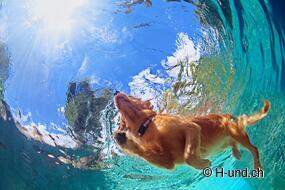Summer, sun, sunshine
How to cool your dog down on hot days

Summer is finally here! For many people, the best season of the year is now beginning. T-shirt weather, the swimming season is open, relaxed barbecues with friends, ice cream, etc. And all this in wonderfully warm temperatures. And if our four-legged friend can accompany us, the day is perfect.
But how do our dogs feel about these hot days?
Did you know that it can be too hot for our dogs when the temperature exceeds 15 degrees? If the temperature rises to over 20 degrees, most dogs already reduce their physical activity. This is because dogs cannot sweat like humans. They do have a few sweat glands on their paws, but these are mainly used to leave scent marks.
So how do dogs cool themselves down? Mainly by panting. Dogs breathe in shallowly and quickly (up to 300 times per minute) through the nose and out through the mouth - the air that passes over the dog's tongue provides evaporative cooling and supports thermoregulation. So you can imagine that this doesn't really cool them down. Then there is also the sometimes thick fur of the dogs. But of course, every dog reacts differently to hot temperatures. The origin and physical characteristics of the dogs play a role here. Short-nosed breeds, for example, suffer particularly badly. Even light physical activity may be enough for these breeds to suffer from overheating and, in the worst case, heat stroke.
So how can we make the hot season as pleasant as possible for our dogs? We have put together a few tips for you:
- Just let the dog be a dog. Chilling out is the order of the day. Reduce joint activities and walks to a minimum and choose the cooler morning and late evening hours.
- Adapt walking routes. Instead of strolling through the city or walking along country lanes, choose cool forest paths. The natural shade is much more pleasant than artificial shade. In addition, the asphalt can get brutally hot and this in turn can lead to severe burns on the pads of the paws. You can also go for a walk by a lake. Your dog can cool off in the water from time to time.
- Water games & Co. If your dog is not afraid of water, take him swimming/bathing. A life jacket can help here if the dog does not feel constricted. Dogs can also suffer from circulatory collapse if they cool down too quickly and suddenly. Therefore, wet their paws and legs beforehand and start slowly. In addition, dogs should not bathe for more than 10 minutes in water that is less than 10 degrees. This is particularly important for water-loving dogs. With water-shy dogs, proceed in small steps and do not overtax the dog. Look for a shallow spot where the dog can only put its paws in the water at first and it slowly gets deeper and deeper. Fishing treats out of the water is great fun for most dogs and can help them lose their fear of the cool water. BUT BE CAREFUL - DANGERS IN THE WATER!
- Prepare cool and shady places. Make sure your dog can lie in the shade. A cellar, cool tiles or a place under a tree in the garden will provide some cooling. Alternatively, you can also lay a wet towel on the floor. Personally, I don't put cooling vests or wet T-shirts on my dogs because they can't escape them.
- Ice - cooling from the inside. This can also be a varied measure for our dogs (in small quantities and to be enjoyed with caution). BUT BEWARE: ice cream can contain ingredients that are poisonous to dogs. In addition, eating ice cream can lead to stomach upsets or worse in dogs. If you do, then make ice cream especially for dogs. Whether with fruit, liverwurst or cheese, depending on your dog's taste, there are some great recipes out there(don't use milk or cream, as they are not easily digested by dogs). Toys with a hole are particularly good for fun. I can fill these and the dogs have something to do for longer.
- Grooming. This should of course be taken care of all year round, but is even more important in summer. This also helps your dog on hot days. Regular brushing is therefore a must.
PRINCIPLES
- Provide sufficient drinking water. Should go without saying.
- No sporting activities - especially not in the midday sun.
- Never leave your dog in the car!
- Asphalt floor check: Even at an air temperature of 25 degrees Celsius, the asphalt can become up to 50 degrees hot and cause third-degree burns.

When having fun in the water with your dog, you should pay particular attention to the following things:
- Water poisoning: When jumping around, playing, fishing treats out of the water or even retrieving objects, the dog absorbs water. If he ingests too much water, this can lead to an imbalance in his electrolyte balance. Symptoms can include nausea, vomiting, impaired coordination and even seizures.
- Blue-eyed algae: These algae are often found in warm, nutrient-rich and stagnant waters. Contact or ingestion (including licking from wet paws) can lead to severe neurological disorders. Seizures, breathing problems and disorientation can also occur. This poisoning can also be fatal. Blue-eyes can be recognized by a bluish haze/film on the surface of the water. As a rule, clear running water does not pose a danger. Unfortunately, exceptions prove the rule. Pay attention to the following points:
- Cloudy water, no bottom can be seen.
- Formation of streaks or algae carpets
- Water appears greenish or bluish in color
- Cloud-like distribution in the water
- Dead fish floating on the surface of the water
If in doubt: keep your dog away from the water. More information about blue-green algae
- Bacteria and parasites: Especially in summer, stagnant water can cause diseases. Bacteria such as leptospirosis (infected urine from rats and mice) or parasites such as giardia can be transmitted to your dog through the water. Dogs with a weak immune system are particularly at risk of becoming seriously ill. Don't let your dogs drink from puddles, especially in summer.
- Salt poisoning: Some dogs still like to drink sea water. Make sure that your dog does not drink too much salt water. Salt poisoning leads to neurological symptoms or dehydration.
- Water rod: Water rod, or mutton tail, can be very painful for dogs. Water tail can be recognized by the fact that the dog's tail hangs limply and sticks out horizontally at the base. Affected dogs often avoid sitting and lying down. They also feel unwell and sickly. Water tails usually occur during intense activity in the water. Make sure you give your dog enough breaks, dry him off well and don't let him into cold water. If you think your dog is affected, a visit to the vet makes sense. The symptoms often subside after one to two weeks. Rest your dog. Anti-inflammatory medication can support the healing process.
Text/Picture: Anja Papenberg & Livia Waser




